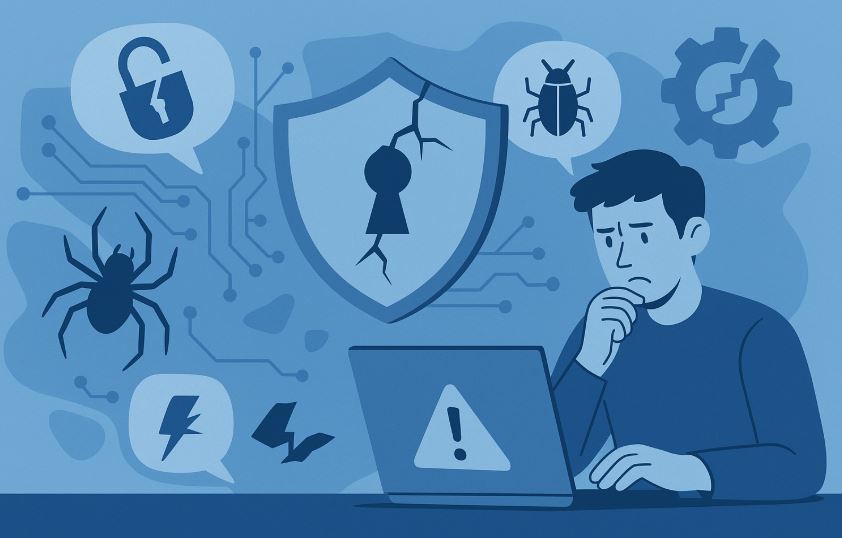
What Makes a System Vulnerable in the Digital Age?
In a world that runs on software, networks, and constant connectivity, cyber attacks are not just a possibility, they’re an inevitability. But have you ever wondered how these attacks succeed? How do cyber criminals find their way into otherwise secure systems?
The answer lies in a single word: vulnerability.
A vulnerability in cyber security is a flaw or weakness within systems, software, configurations, or even human behaviour that can be exploited by a threat actor.
These flaws serve as doorways, often unnoticed, that allow malicious parties to bypass controls, gain unauthorised access, steal data, disrupt operations, or plant malware.
Vulnerabilities exist across the technological landscape, from outdated hardware to misconfigured cloud environments, and even in employee practices such as weak password use or falling victim to phishing schemes.
Understanding and addressing these vulnerabilities is no longer optional, it’s essential. In this blog, we explore what vulnerabilities are, why they matter, how they’re exploited, and what businesses must do to protect themselves from becoming the next headline breach.
What is the True Definition of a Vulnerability in Cyber Security?

At its core, a cyber security vulnerability is any weakness in a system’s design, implementation, configuration, or operation that could be exploited to violate the system’s security policy. This weakness may reside in software, hardware, network architecture, or even human processes.
Unlike threats, which refer to the potential of something harmful happening, a vulnerability is the specific entry point that an attacker might use. If a system contains vulnerabilities, it becomes an attractive target because attackers can use these flaws to execute unauthorised commands, gain access to data, or affect operations.
For example, a database that accepts input without validation may be vulnerable to SQL injection attacks. A cloud storage bucket left publicly accessible due to misconfiguration becomes an invitation for data leakage.
To summarise the distinction between commonly confused terms:
| Term | Description |
| Vulnerability | A flaw or weakness in a system |
| Threat | A potential danger (e.g. hacker, malware) |
| Exploit | A method used to take advantage of a vulnerability |
| Risk | The potential impact when a vulnerability is exploited |
Where Do Vulnerabilities Come From?
Vulnerabilities don’t arise from a single source. They originate from a combination of technical limitations, process oversights, and human error. Several factors contribute to the development of security weaknesses in systems.
First, complexity increases the chances of mistakes. As systems become more sophisticated and interconnected, the number of components interacting with one another grows, which in turn increases the chances of coding errors, misconfigurations, and overlooked settings.
Second, familiarity and reuse of common software components and libraries make vulnerabilities widespread. If a popular framework contains a flaw, thousands of systems can become exposed to the same threat.
Third, human factors play a significant role. Poor password management, lack of cyber security awareness, and carelessness in managing access controls can lead to accidental exposures.
Finally, inadequate update and patch management means systems remain exposed even after vulnerabilities are publicly disclosed. Delays in applying security patches give attackers the time they need to exploit known issues.
What Are the Different Types of Vulnerabilities in Cyber Security?
Cyber security vulnerabilities can be grouped into two broad categories: technical vulnerabilities and human-centric vulnerabilities. Each represents different but equally important attack surfaces.
Technical Vulnerabilities
Technical vulnerabilities exist in hardware, software, or system configurations and are usually the result of coding flaws, misconfigurations, or outdated technologies.
- Unpatched software: Systems not updated with the latest security patches are vulnerable to attacks exploiting known flaws. This is how the infamous WannaCry ransomware attack spread rapidly in 2017.
- Weak authentication: Using default credentials or weak passwords makes it easier for attackers to gain access.
- Misconfigured cloud storage: In 2020, a major UK-based travel insurance firm suffered a breach due to misconfigured AWS S3 storage, exposing sensitive policyholder data.
- Unsafe protocols: Relying on outdated or insecure protocols such as FTP or HTTP rather than their secure counterparts can leak data during transmission.
- Input validation errors: Poor input validation can allow attackers to inject malicious code, leading to command injection or XSS attacks.
Human-Centric Vulnerabilities
These vulnerabilities arise from mistakes, negligence, or lack of awareness among users and administrators.
- Phishing susceptibility: Social engineering remains one of the most effective attack vectors. A 2021 case in Europe saw a law firm’s internal network compromised after an employee clicked a malicious email link.
- Poor password hygiene: Reusing weak passwords across multiple platforms exposes users to credential-stuffing attacks.
- Privilege misuse: Giving employees more access than needed increases the risk of insider threats.
- Lack of training: Without basic security awareness training, employees are likely to fall for increasingly sophisticated cyber attacks.
How Are Vulnerabilities Exploited by Attackers?

Cyber attackers follow a relatively standard process when exploiting vulnerabilities, regardless of their target or tools. The process generally consists of the following stages:
- Discovery: Attackers use automated tools to scan for known vulnerabilities or exposed systems. Google hacking techniques or vulnerability scanners help them identify targets.
- Assessment and Exploitation: Once a vulnerability is identified, an exploit is crafted to take advantage of the flaw. Attackers may chain together multiple vulnerabilities to escalate their privileges.
- Execution: The exploit is deployed, allowing attackers to gain unauthorised access, install malware, exfiltrate data, or disrupt operations.
- Lateral Movement: After gaining initial access, attackers move across the network to gain deeper control and access to critical systems.
This process illustrates how a single vulnerability can act as a gateway to a much larger breach.
What is the Role of Vulnerability Management in Cyber Defence?
Vulnerability management is a structured approach to identifying, evaluating, prioritising, and remediating security weaknesses across IT environments. It is a continuous and proactive process that helps reduce the attack surface and prevent potential breaches.
Stages of Vulnerability Management
| Stage | Description |
| Identification | Use of tools like Nessus, OpenVAS, or Microsoft Defender to discover weaknesses in networks, applications, and endpoints |
| Assessment | Analysis of the risk level using frameworks like CVSS (Common Vulnerability Scoring System) to prioritise response |
| Prioritisation | Focusing resources on critical vulnerabilities, especially those with available exploits or affecting essential systems |
| Remediation | Fixing the issues through patching, reconfiguration, or access changes; may also involve user training |
| Verification & Monitoring | Ensuring that remediation steps are effective and that new vulnerabilities are continuously detected |
Effective vulnerability management not only strengthens cyber defences but also supports regulatory compliance with standards like GDPR, ISO 27001, and PCI DSS.
When is a Vulnerability Considered a Real Threat?
Not every vulnerability translates into an immediate risk. A vulnerability becomes dangerous when:
- It has a known working exploit
- It affects critical systems
- There’s no current mitigation or patch
- It is being actively targeted by threat actors
The Common Vulnerabilities and Exposures (CVE) database, managed by MITRE, is a publicly accessible system that catalogues known vulnerabilities. Each CVE is assigned a CVSS score between 0 and 10 to help organisations assess urgency.
For instance, a remote code execution vulnerability in an unpatched CMS plugin might score 9.8, indicating critical severity, especially if it’s being actively exploited in the wild.
Why Do Public Disclosures of Vulnerabilities Matter?

Whether vulnerabilities should be disclosed publicly has long been debated. On one hand, immediate disclosure forces vendors to act quickly, leading to faster patching and greater transparency.
On the other hand, public disclosure may provide cyber criminals with the information they need to exploit the flaw before a patch is available.
Responsible disclosure, the most common method today, allows researchers to notify vendors privately and give them time to address the issue before details are made public.
Platforms like HackerOne and Bugcrowd support this approach through bug bounty programmes that incentivise ethical reporting of vulnerabilities.
What Are Some Examples of High-impact Vulnerabilities?
Throughout recent years, there have been several high-profile cases where overlooked vulnerabilities led to serious breaches:
- Log4Shell (CVE-2021-44228): A critical vulnerability in the Apache Log4j library, affecting millions of applications worldwide, allowed remote code execution on servers.
- Citrix ADC Remote Code Execution (2019): This vulnerability impacted corporate VPNs and allowed attackers to bypass authentication.
- Accellion File Transfer Appliance (2020): A zero-day vulnerability was exploited to steal data from multiple global enterprises, highlighting risks in third-party tools.
These examples underscore how vulnerabilities can exist even in widely trusted systems and tools.
How Can Organisations Reduce the Risk of Vulnerabilities Being Exploited?
Mitigating vulnerabilities doesn’t require perfection, it demands consistency and prioritisation. Organisations can take several practical steps:
- Apply software updates and security patches as soon as they’re released
- Conduct regular vulnerability assessments and penetration tests
- Remove or replace unsupported systems and applications
- Educate employees on cyber hygiene, especially regarding phishing
- Implement strong password policies and multi-factor authentication
- Review cloud configurations and limit unnecessary access permissions
A strong vendor risk management strategy is also critical to reduce third-party and fourth-party risk, especially as more companies rely on outsourced IT services and cloud platforms.
What’s the Future of Vulnerability Detection and Prevention?
As attack methods evolve, so must the techniques for vulnerability detection. The future of vulnerability management lies in automation, artificial intelligence, and real-time monitoring.
AI-powered platforms now analyse patterns to detect potential vulnerabilities before they’re exploited. Predictive analytics are being used to estimate which flaws are most likely to be targeted based on emerging threat intelligence.
In parallel, the adoption of zero trust architectures is growing. This model assumes no user or system is trusted by default, making it more difficult for attackers to move laterally once inside.
FAQs about Cyber Security Vulnerabilities
What is the difference between a vulnerability and a misconfiguration?
A vulnerability is a weakness in code or hardware. A misconfiguration is an incorrect setup or insecure default setting that can expose vulnerabilities or open new ones.
Are zero-day vulnerabilities more dangerous?
Yes, because they are unknown to the vendor and often have no patch available when first discovered, making them highly exploitable.
Can vulnerabilities exist in hardware?
Absolutely. Hardware flaws, like those found in CPUs or firmware, can be exploited and are often harder to fix than software issues.
Is vulnerability scanning enough for protection?
Scanning is a good starting point, but it’s not sufficient. Manual testing, configuration reviews, and employee training are also critical.
How often should penetration testing be done?
At least annually, or after any major system update or migration. High-risk industries may require more frequent testing.
Does regulatory compliance ensure vulnerability protection?
Compliance helps, but it’s not foolproof. Many breaches occur in compliant organisations. Continuous improvement is key.
Can small businesses be targeted through vulnerabilities?
Yes. Small businesses are often more vulnerable due to limited security resources, making them attractive to cyber criminals.